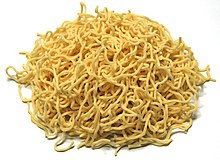Cookbook:Ramen
Cookbook | Recipes | Ingredients | Equipment | Techniques | Cookbook Disambiguation Pages | Cuisine of Japan

Ramen is a Japanese noodle soup with roots in China, consisting of broth, ramen noodles, and toppings.
History
editRamen emerged in Japan sometime between the 18th and early 20th centuries, coming from Chinese cuisine. As such, the term "ramen" is derived from the Japanese pronunciation of the Chinese la mian (拉麺), meaning "pulled noodles". It became extremely popular after World War II and has since been primarily associated with Japan and Japanese culture instead of its Chinese origins.
Types
editThere is an extremely diverse assortment of ramen soups, varying according to local cultures, personal tastes, and ingredient availability. They can be primarily characterized by their broth and toppings.
Broth
editRamen broth ranges from light (assari) to thick and rich (kotteri). Assari broths tend to be thin and clear, while kotteri broths are thicker, opaque, and fatty. The broth can be made by simmering a range of ingredients, including meat and bones, vegetables, seafood, kelp, onions, ginger, mushrooms, garlic, and/or scallions. The broth is typically seasoned or salted with sea salt (shio), soy sauce (shoyu), miso, and/or MSG.
Toppings
editToppings are highly varied and can include the following:
- Chashu pork: tender soy- and mirin-simmered pork
- Bacon
- Scallions
- Simmered seafood
- Boiled eggs
- Tamago eggs
- Kamaboko fish cake
- Cabbage
- Enoki or wood-ear mushrooms
- Nori or wakame
- Fresh or stir-fried vegetables
Bowls of ramen may also be finished with togarashi powder, sesame seeds, curry powder/paste, or a dash of some oil/fat.
Eating
editRamen is eaten with chopsticks, and the noodles are slurped quickly before they turn soggy in the broth. The broth may be sipped with large spoons or directly from the bowl.
Recipes
editExternal links
edit- https://www.thespruceeats.com/what-is-ramen-5213797
- https://www.seriouseats.com/the-serious-eats-guide-to-ramen-styles
- https://www.atlasobscura.com/articles/how-did-ramen-become-popular
- https://www.kikkoman.com/en/foodforum/the-japanese-table/32-4.html
- https://www.japan.travel/en/guide/ramen/
- https://www.japan-guide.com/e/e2042.html
- https://firstwefeast.com/eat/2014/05/george-solt-on-the-messy-history-of-ramen